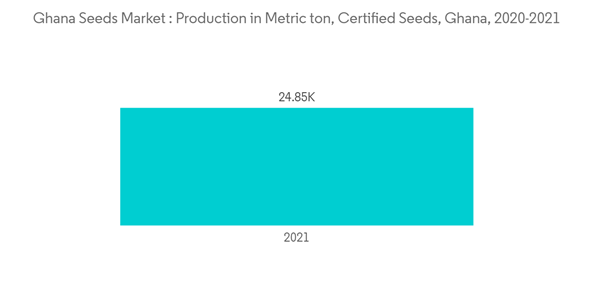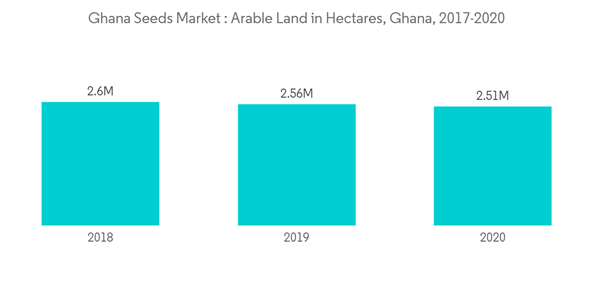The Ghana Seeds Market size is estimated at USD 9.29 million in 2024, and is expected to reach USD 11.09 million by 2029, growing at a CAGR of 3.60% during the forecast period (2024-2029).
Crops such as corn, rice, cowpea, soybean, sorghum, and peanut are mainly regulated for seed production in Ghana, among which corn and rice seeds form the bulk of certified seed production. The Ghana Seed Inspection Division (GSID) of the Ministry of Food and Agriculture (MOFA) is the Government of Ghana's institution mandated to inspect and certify seeds produced at every stage of seed production from the production of Breeder's seed, foundation seed, and certified seed.
Government initiatives such as subsidy programs are a prominent factor behind the increased production of certified seeds in the country. For instance, according to the Ministry of Food and Agriculture, Ghana, the total production of certified seeds in Ghana in 2020 was 17,204.94 metric tons which increased by approximately 44.5% and reached 24,854 metric tons in 2021. Furthermore, due to government initiatives, the number of registered private seed companies supplying certified has also grown from 203 in 2020 to 452 in 2021.
Moreover, initiatives launched by several authorities are further boosting the demand for certified seeds in the region. For instance, in November 2022, The Board of Directors of the African Development Fund approved a USD 27.9 million grant to Ghana to develop the agricultural value chain in the Savannah region. The grant will support farmers with farm inputs to produce climate-resilient rice, maize, and soybean. It will also support the production of certified seeds.
The need to increase production from the fluctuating arable land to get higher returns can be met using HYVs and hybrid varieties. This trend encourages farmers to shift their focus from conventional seed sources to packaged seeds, which promise better returns. Hence, to meet the increasing food demand, the production of crops, such as cereals and pulses, needs to increase despite the limited availability of arable land. This has propelled the farmers in the country to adopt high-yielding varieties to produce more within the limited available land. This, in turn, drives the growth of the market.
The fluctuating arable land is encouraging corporations and farmers to pool their resources for contract farming, especially for crops such as maize and rice in the country. The increasing contract farming practices help converge a large set of farmers to one point for seed selection. This maintains uniformity in the produce, thereby assisting the seller in obtaining sustainable demand and augmenting the bulk sale of seeds.
Maize is a staple food and plays a significant role in Ghana's food security. The GOG exerts considerable pressure to ensure adequate maize production to meet domestic consumption requirements. Therefore, maize hybrid seed use is becoming highly important for Ghana to reach its targeted production. Thus, government policies promoting the development of the seed sector to ensure sufficient domestic production are expected to drive the market.
The major players within the market are majorly focusing on research and development activities to produce new seed varieties, which are embedded with the characteristics of high yield and reduced crop damage.
This product will be delivered within 2 business days.
Key Highlights
- Ghana's seed sector has grown significantly over the last decade; with the development and availability of improved and locally adapted seed varieties, the adoption rate is still marginal, with just about 30 percent of farmers using improved varieties as of 2022.
- As a result of population expansion and a steady land degradation rate, the per capita land is anticipated to decrease in Ghana. The decreasing per capita availability of arable land is a significant concern for ghana agricultural production. However, it is considered to be a driver for the seed industry. The need to produce more from the decreasing per capita arable land to get higher returns can be possible using high-yielding and hybrid varieties. This trend encourages farmers to shift their focus from conventional seed sources to packaged seeds that promise better returns.
- Moreover, the demand for seeds across the country is still untapped and provides multinational corporations with various opportunities for expansion and a broad customer base. Also, the increased area under cultivation of vegetables on account of the changing dietary preferences of the population, as well as the increased cash flows received by farmers on history of vegetable cultivation, is further driving the growth of the seed market in Ghana.
- Furthermore, several players are taking initiatives to boost the growth of the seed market. For instance, an initiative like "1" Household, 1 Garden" "un by Agrihouse Foundation in Ghana is motivating and supporting the people of ghana to contribute to the growth of the seed market.
Ghana Seed Market Trends
Growing Demand for Certified Seeds
Quality seeds are a prerequisite to thriving agriculture and constitute a significant pathway for achieving national food security goals for Ghana, where agriculture is the prime mover of the national economy.Crops such as corn, rice, cowpea, soybean, sorghum, and peanut are mainly regulated for seed production in Ghana, among which corn and rice seeds form the bulk of certified seed production. The Ghana Seed Inspection Division (GSID) of the Ministry of Food and Agriculture (MOFA) is the Government of Ghana's institution mandated to inspect and certify seeds produced at every stage of seed production from the production of Breeder's seed, foundation seed, and certified seed.
Government initiatives such as subsidy programs are a prominent factor behind the increased production of certified seeds in the country. For instance, according to the Ministry of Food and Agriculture, Ghana, the total production of certified seeds in Ghana in 2020 was 17,204.94 metric tons which increased by approximately 44.5% and reached 24,854 metric tons in 2021. Furthermore, due to government initiatives, the number of registered private seed companies supplying certified has also grown from 203 in 2020 to 452 in 2021.
Moreover, initiatives launched by several authorities are further boosting the demand for certified seeds in the region. For instance, in November 2022, The Board of Directors of the African Development Fund approved a USD 27.9 million grant to Ghana to develop the agricultural value chain in the Savannah region. The grant will support farmers with farm inputs to produce climate-resilient rice, maize, and soybean. It will also support the production of certified seeds.
Decrease in Arable Land
The decreasing per capita availability of arable land is a major concern for agricultural production in Ghana. The arable land in Ghana was reduced from 2017 to 2020. The total arable land in Ghana in 2017 was around 2,652,000 hectares which declined by approximately 5.2% and reached 2,513,400 hectares in 2020.The need to increase production from the fluctuating arable land to get higher returns can be met using HYVs and hybrid varieties. This trend encourages farmers to shift their focus from conventional seed sources to packaged seeds, which promise better returns. Hence, to meet the increasing food demand, the production of crops, such as cereals and pulses, needs to increase despite the limited availability of arable land. This has propelled the farmers in the country to adopt high-yielding varieties to produce more within the limited available land. This, in turn, drives the growth of the market.
The fluctuating arable land is encouraging corporations and farmers to pool their resources for contract farming, especially for crops such as maize and rice in the country. The increasing contract farming practices help converge a large set of farmers to one point for seed selection. This maintains uniformity in the produce, thereby assisting the seller in obtaining sustainable demand and augmenting the bulk sale of seeds.
Maize is a staple food and plays a significant role in Ghana's food security. The GOG exerts considerable pressure to ensure adequate maize production to meet domestic consumption requirements. Therefore, maize hybrid seed use is becoming highly important for Ghana to reach its targeted production. Thus, government policies promoting the development of the seed sector to ensure sufficient domestic production are expected to drive the market.
The major players within the market are majorly focusing on research and development activities to produce new seed varieties, which are embedded with the characteristics of high yield and reduced crop damage.
Ghana Seed Industry Overview
The Ghana Seeds Market is fragmented. Rijk Zwaan Zaadteelt En Zaadhandel BV, M&B Seeds, RMG Ghana Ltd, Seed Co Limited, and Corteva AgriScience are some of the major players operating in the market. The players are investing in new products and improvisation of products, partnerships, expansions, and acquisitions for business expansions.Additional Benefits:
- The market estimate (ME) sheet in Excel format
- 3 months of analyst support
This product will be delivered within 2 business days.
Table of Contents
1 INTRODUCTION
4 MARKET DYNAMICS
5 MARKET SEGMENTATION
6 COMPETITIVE LANDSCAPE
Companies Mentioned (Partial List)
A selection of companies mentioned in this report includes, but is not limited to:
- Seed Co. Limited
- Rijk Zwaan Zaadteelt En Zaadhandel BV
- M&B Seeds
- RMG Ghana Ltd
- Groupe Limagrain
- Syngenta AG
- Corteva Agriscience
Methodology

LOADING...










